Length 2.9 m (Adult) Trophic level Herbivorous | Phylum Chordata Order Artiodactyla Mass 610 kg (Adult) Gestation period 266 days | |
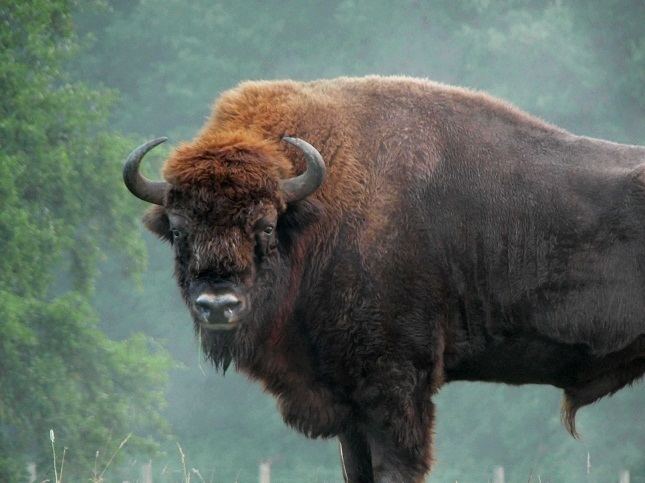 | ||
Conservation status Vulnerable (Population increasing) Similar Bison, American bison, Aurochs, Cervus, Pumas | ||
The European bison (Bison bonasus), also known as wisent (/ˈviːzənt/ or /ˈwiːzənt/) or the European wood bison, is a Eurasian species of bison. It is one of two extant species of bison, alongside the American bison. Three subspecies existed in the recent past, but only one survives today. The species is descended from a hybrid, a cross between a female Aurochs, the extinct wild ancestor of modern cattle, and a male Steppe bison; the original hybrid is known informally as the Higgs bison.
Contents
- European bison bia owie a national park bia owie a podlaskie poland europe
- Description
- Etymology
- History
- Genetic history
- Differences from American bison
- Social structure and territorial behaviours
- Reproduction
- Diet
- Conservation
- Reintroduction
- Numbers
- Distribution
- References

European bison were hunted to extinction in the wild in the early 20th century, with the last wild animals of the B. b. bonasus subspecies being shot in the Białowieża Forest (on the Poland-Belarus border) in 1921, and the last of B. b. caucasus in the northwestern Caucasus in 1927. B. b. hungarorum was hunted to extinction in the mid-1800s. The Białowieża or lowland European bison was kept alive in captivity, and has since been reintroduced into several countries in Europe. They are now forest-dwelling. The species has had few recent predators besides humans, with only scattered reports from the 19th century of wolf and bear predation. European bison were first scientifically described by Carl Linnaeus in 1758. Some later descriptions treat the European bison as conspecific with the American bison. It is not to be confused with the aurochs, the extinct ancestor of domestic cattle.
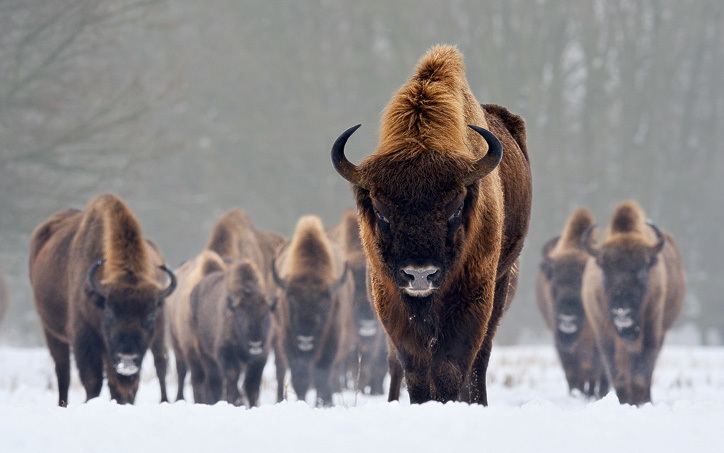
In 1996, the International Union for Conservation of Nature classified the European bison as an endangered species. Its status has since been changed to being a vulnerable species. In the past, especially during the Middle Ages, it was commonly killed for its hide, and to produce drinking horns.
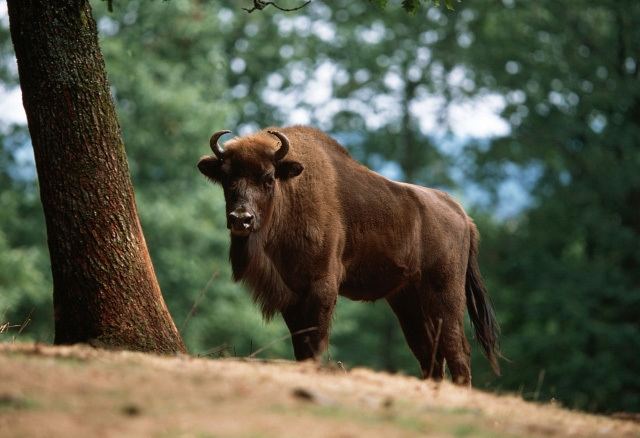
European bison bia owie a national park bia owie a podlaskie poland europe
Description
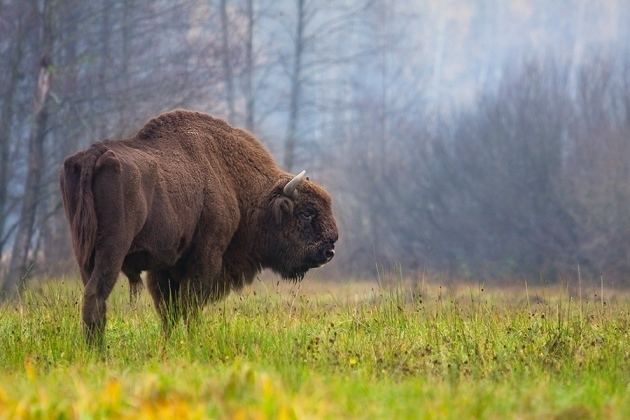
The European bison is the heaviest surviving wild land animal in Europe; a typical European bison is about 2.1 to 3.5 m (6.9 to 11.5 ft) long, not counting a tail of 30 to 80 cm (12 to 31 in) long, and 1.6 to 1.95 m (5.2 to 6.4 ft) tall. At birth, calves are quite small, weighing between 15 and 35 kg (33 and 77 lb). In the free-ranging population of the Białowieża Forest of Belarus and Poland, body masses among adults (aged 6 and over) are 634 kg (1,398 lb) on average in the cases of males, with a range of 400 to 920 kg (880 to 2,030 lb), and of 424 kg (935 lb) among females, with a range of 300 to 540 kg (660 to 1,190 lb). An occasional big bull European bison can weigh up to 1,000 kg (2,200 lb) or more.
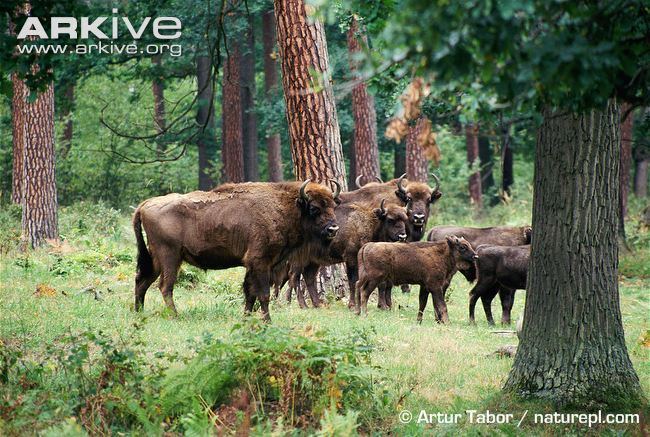
On average, it is slightly lighter in body mass and yet taller at the shoulder than the American bison (Bison bison). Compared to the American species, the wisent has shorter hair on the neck, head, and forequarters, but longer tail and horns.
Etymology
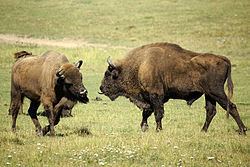
The modern English word wisent was borrowed in the 19th century from modern German Wisent [ˈviːzɛnt], itself from Old High German wisunt, wisant, related to Old English wesend, weosend, and Old Norse vísundr. The Old English cognate disappeared as the bison's range shrank away from English-speaking areas by the Late Middle Ages.
The English word bison was borrowed around 1611 from Latin bisōn (pl. bisontes), itself from Germanic. The root *wis-, also found in weasel, originally referred to the animal's musk.
The word bonasus was first mentioned by Aristotle in the fourth century BC when he precisely described the animal, calling it βόνασος (bonasos) in Greek. He also noted that the Paeonians called it μόναπος (monapos).
History
Historically, the lowland European bison's range encompassed most of the lowlands of northern Europe, extending from the Massif Central to the Volga River and the Caucasus. It may have once lived in the Asiatic part of what is now the Russian Federation. The European bison is known in southern Sweden only between 9500 and 8700 BP, and in Denmark similarly is documented only from the Pre-Boreal. It is not recorded from Britain or Ireland nor from Italy or the Iberian Peninsula. Its presumed ancestor, the extinct long-horned steppe bison, B. priscus, is known from Britain, last occurring in the Denekamp interstadial of the Weichselian glaciation and is depicted in the Cave of Altamira and Lascaux. Cave paintings appear to distinguish between B. bonasus and B. priscus.
Within mainland Europe, its range decreased as human populations expanded and cut down forests. The last references (Oppian, Claudius Aelianus) to the animal in the transitional Mediterranean/Continental biogeographical region in the Balkans in the area of modern borderline between Greece, Macedonia, and Bulgaria date to the third century AD. Its population in Gaul was extinct in the 8th century AD. The species survived in the Ardennes and the Vosges Mountains until the 15th century. In the Early Middle Ages, the wisent apparently still occurred in the forest steppes east of the Urals, in the Altay Mountains, and seems to have reached Lake Baikal in the east. The northern boundary in the Holocene was probably around 60°N in Finland.
European bison survived in a few natural forests in Europe, but their numbers dwindled. The last European bison in Transylvania died in 1790. In Poland, European bison in the Białowieża Forest were legally the property of the Polish kings until the third partition of Poland. Wild European bison herds also existed in the forest until the mid-17th century. Polish kings took measures to protect the bison. King Sigismund II Augustus instituted the death penalty for poaching a European bison in Białowieża in the mid-16th century. In the early 19th century, Russian czars retained old Polish laws protecting the European bison herd in Białowieża. Despite these measures and others, the European bison population continued to decline over the following century, with only Białowieża and Northern Caucasus populations surviving into the 20th century.
During World War I, occupying German troops killed 600 of the European bison in the Białowieża Forest for sport, meat, hides, and horns. A German scientist informed army officers that the European bison were facing imminent extinction, but at the very end of the war, retreating German soldiers shot all but nine animals. The last wild European bison in Poland was killed in 1921. The last wild European bison in the world was killed by poachers in 1927 in the western Caucasus. By that year, fewer than 50 remained, all held by zoos.
To help manage this captive population, Dr. Heinz Heck began the first studbook for a nondomesticated species, initially as a card index in 1923, leading to a full publication in 1932.
Genetic history
A 2003 study of mitochondrial DNA indicated four distinct maternal lineages in the tribe Bovini:
Y chromosome analysis associated wisent and American bison. An earlier study, using amplified fragment-length polymorphism fingerprinting, showed a close association of wisent and American bison and probably with yak. It noted the interbreeding of Bovini species made determining relationships problematic.
European bison can cross-breed with American bison. The products of a German interbreeding programme were destroyed after the Second World War. This programme was related to the impulse which created the Heck cattle. The cross-bred individuals created at other zoos were eliminated from breed books by the 1950s. A Russian back-breeding programme resulted in a wild herd of hybrid animals, which presently lives in the Caucasian Biosphere Reserve (550 animals in 1999).
Wisent-cattle hybrids also occur, similar to North America beefalo. Cattle and European bison hybridise fairly readily, but the calves cannot be born naturally (birth is not triggered correctly by the first-cross hybrid calf, so they must be delivered by caesarian section). First-generation males are infertile. In 1847, a herd of wisent-cattle hybrids named żubroń was created by Leopold Walicki. The animals were intended to become durable and cheap alternatives to cattle. The experiment was continued by researchers from the Polish Academy of Sciences until the late 1980s. Although the program resulted in a quite successful animal that was both hardy and could be bred in marginal grazing lands, it was eventually discontinued. Currently, the only surviving żubroń herd consists of just a few animals in Białowieża Forest, Poland and Belarus.
In 2016, the first whole genome sequencing data from two European bison bulls from the Bialowieza Forest revealed that the bison and bovine species diverged from about 1.7 to 0.85 Mya through a speciation process involving limited gene flow. These data further support the occurrence of more recent secondary contacts, posterior to the Bos taurus and Bos indicus divergence (ca. 150,000 years ago), between the wisent and (European) taurine cattle lineages. An independent study of mitochondrial DNA and autosomal markers confirmed these secondary contacts (with an estimate of up to 10% of bovine ancestry in the modern wisent genome) leading the authors to go further in their conclusions by proposing the wisent to be a hybrid between steppe bison and aurochs with an hybridization event originating before 120,000 years ago. This is also consistent with the apparent Bos origin of the mitochondrial DNA.
Some of authors however support the hypothesis that similarity of wisent and cattle (Bos) mitochondrial genomes is result of incomplete lineage sorting during divergence of Bos and Bison from their common ancestors rather than further post-speciation gene flow (ancient hybridization between Bos and Bison). But they agree that limited gene flow from Bos primigenius taurus could account for the affiliation between wisent and cattle nuclear genomes (in contrast to mitochondrial ones).
Differences from American bison
Although superficially similar, a number of physical and behavioural differences are seen between the European bison and the American bison. The European bison has 14 pairs of ribs, while the American bison has 15. Adult European bison are (on average) taller than American bison, and have longer legs. European bison tend to browse more, and graze less than their American relatives, due to their necks being set differently. Compared to the American bison, the nose of the European bison is set further forward than the forehead when the neck is in a neutral position.
The body of the European bison is less hairy, though its tail is hairier than that of the American species. The horns of the European bison point forward through the plane of their faces, making them more adept at fighting through the interlocking of horns in the same manner as domestic cattle, unlike the American bison, which favours charging. European bison are less tameable than the American ones, and breed with domestic cattle less readily.
Social structure and territorial behaviours
The European bison is a herd animal, which lives in both mixed and solely male groups. Mixed groups consist of adult females, calves, young aged 2–3 years, and young adult bulls. The average herd size is dependent on environmental factors, though on average, they number eight to 13 animals per herd. Herds consisting solely of bulls are smaller than mixed ones, containing two individuals on average. European bison herds are not family units. Different herds frequently interact, combine, and quickly split after exchanging individuals.
Territory held by bulls is correlated by age, with young bulls aged between five and six tending to form larger home ranges than older males. The European bison does not defend territory, and herd ranges tend to greatly overlap. Core areas of territory are usually sited near meadows and water sources.
Reproduction
The rutting season occurs from August through to October. Bulls aged 4–6 years, though sexually mature, are prevented from mating by older bulls. Cows usually have a gestation period of 264 days, and typically give birth to one calf at a time.
On average, male calves weigh 27.6 kg (60.8 lb) at birth, and females 24.4 kg (53.8 lb). Body size in males increases proportionately to the age of 6 years. While females have a higher increase in body mass in their first year, their growth rate is comparatively slower than that of males by the age of 3–5. Bulls reach sexual maturity at the age of two, while cows do so in their third year.
European bison have lived as long as 30 years in captivity, although in the wild their lifespans are shorter. Productive breeding years are between four and 20 years of age in females, and only between six and 12 years of age in males.
Diet
European bison feed predominantly on grasses, although they also browse on shoots and leaves; in summer, an adult male can consume 32 kg of food in a day. European bison in the Białowieża Forest in Poland have traditionally been fed hay in the winter for centuries, and vast herds may gather around this diet supplement. European bison need to drink every day, and in winter can be seen breaking ice with their heavy hooves. Despite their usual slow movements, European bison are surprisingly agile and can clear 3-m-wide streams or 2-m-high fences from a standing start.
Conservation
The protection of the European bison has a long history; between the 15th and 18th centuries, those in the Forest of Białowieża were protected and their diet supplemented. Efforts to restore this species to the wild began in 1929, with the establishment of the Bison Restitution Centre at Białowieża, Poland. Subsequently, in 1948, the Bison Breeding Centre was established within the Prioksko-Terrasny Biosphere Reserve.
The modern herds are managed as two separate lines – one consisting of only Bison bonasus bonasus (all descended from only seven animals) and one consisting of all 12 ancestors, including the one B. b. caucasicus bull. The latter is generally not considered a separate sub-species because they contain DNA from both B. b. bonasus and B. b. caucasicius, although some scientists classify them as a new subspecies, B. b. montanus. Only a limited amount of inbreeding depression from the population bottleneck has been found, having a small effect on skeletal growth in cows and a small rise in calf mortality. Genetic variability continues to shrink. From five initial bulls, all current European bison bulls have one of only two remaining Y chromosomes.
Reintroduction
Beginning in 1951, European bison have been reintroduced into the wild, including some areas where they were never found wild. Free-ranging herds are currently found in Poland, Lithuania, Belarus, Ukraine, Romania, Russia, Slovakia, Latvia, Kyrgyzstan, and Germany, and in forest preserves in the Western Caucasus. Białowieża Forest, an ancient woodland that straddles the border between Poland and Belarus, is now home to 800 wild bison. Herds have also been introduced in Moldova (2005), Spain (2010), Denmark (2012), Bulgaria (2012) and Czech Republic (2014).
Numbers
The total worldwide population is around 4,663 (including 2,701 free-ranging) and has been increasing. Some local populations are estimated as:
Distribution
Since 1983, a small reintroduced population lives in the Altai Mountains. This population suffers from inbreeding depression and needs the introduction of unrelated animals for "blood refreshment". In the long term, authorities hope to establish a population of about 1,000 animals in the area. One of the northernmost current populations of the European bison lives in the Vologodskaya Oblast in the Northern Dvina River valley at about 60°N. It survives without supplementary winter feeding. Another Russian population lives in the forests around the Desna River on the border between Russia and Ukraine. The north-easternmost population lives in Pleistocene Park south of Chersky in Siberia, a project to recreate the steppe ecosystem which began to be altered 10,000 years ago. Five wisents were introduced on 24 April 2011. The wisents were brought to the park from the Prioksko-Terrasny Nature Reserve near Moscow. Winter temperatures often drop below -50 °C. Four of the five bison have subsequently died due to problems acclimatizing to the low winter temperature.
In June 2012, one male and six females were moved to the Danish island of Bornholm. The plan is to release these animals into the wild after five years of adjusting to the island's environment. The plan is that the bison will aid biodiversity by naturally maintaining open grassland.
In 2011, three bison were introduced into Alladale Wilderness Reserve in Scotland. Plans to move more into the reserve were made, but the project failed due to not being "well thought through". In April 2013, eight European bison (one male, five females, and two calves) were released into the wild in the Bad Berleburg region of Germany, after 850 years of absence since the species became extinct in that region.
Plans are being made to reintroduce two herds in Germany and in the Netherlands in Oostvaardersplassen Nature Reserve in Flevoland as well as the Veluwe. In 2007, a bison pilot project in a fenced area was begun in Zuid-Kennemerland National Park in the Netherlands. Because of their limited genetic pool, they are considered highly vulnerable to illnesses such as foot-and-mouth disease. In March 2016, a herd was released in the Maashorst Nature Reserve in North Brabant. Zoos in 30 countries also have quite a few bison involved in captive-breeding programs.
